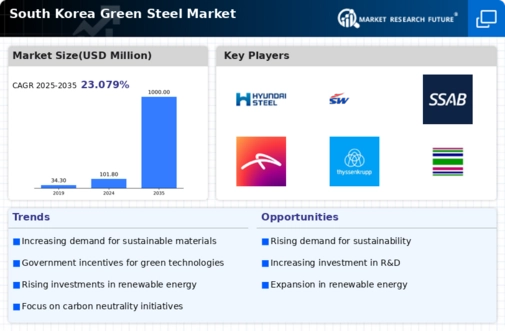The South Korea Green Steel Market is experiencing significant transformation as the country shifts towards more sustainable steel production methods in response to global environmental concerns and regulatory pressures. This shift is being driven by innovations in low-carbon technologies, renewable energy usage, and an emphasis on reducing greenhouse gas emissions. As industries worldwide recognize the necessity of adopting greener practices, the competitive dynamics within the South Korean steel market are evolving. Companies are investing in advanced production techniques, collaborating with research institutions, and aligning their strategies with international sustainability standards.
This landscape has created an opportunity for market players to enhance their competitiveness while fostering partnerships that support green initiatives. The evolving regulatory framework and consumer preferences for eco-friendly products further support this transition, marking a significant step towards a more sustainable steel industry in South Korea.Focusing on Hyundai Steel, the company has been a strong player in the South Korean Green Steel Market, leveraging its technological expertise to enhance production processes aimed at reducing carbon emissions.
Hyundai Steel has established a solid market presence through its investments in green technologies, including the development of hydrogen-based direct reduction iron (DRI) production. The company's commitment to sustainability is evident in its environmental management strategies, which aim to lower carbon footprints throughout its operations. Furthermore, Hyundai Steel has successfully integrated renewable energy sources into its production processes, allowing the company to achieve operational efficiencies and a competitive edge over industry rivals.
The company’s strong brand reputation and extensive distribution networks position it well within the marketplace, ensuring that it meets the evolving demands of environmentally conscious consumers and industry stakeholders.On the other hand, JSW Steel has made significant strides in the South Korea Green Steel Market by focusing on sustainable steel manufacturing practices and expanding its product offerings. The company is known for its commitment to innovation, resulting in the development of eco-friendly steel solutions designed to meet the needs of various industries, including automotive and construction.
JSW Steel’s market presence is bolstered by its strategic mergers and acquisitions aimed at enhancing its technological capabilities and operational efficiencies within the region. Through initiatives that emphasize the adoption of renewable energy, energy-efficient processes, and waste recycling, JSW Steel effectively positions itself as a leader in green steel production. The company's diverse array of products and ability to respond to market trends while maintaining robust environmental practices underlines its strength in the South Korean market.
























Leave a Comment